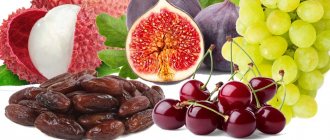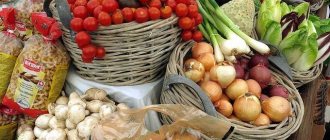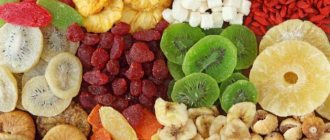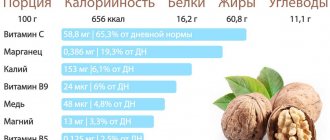Lemon and lime: 5 g sugar per cup1
If you want to choose fruits that are low in sugar, lemon and lime may be the obvious choice due to their sour taste. Although lemons and limes are not fruits that are typically eaten whole, you can use them to add flavor to dishes and drinks while adding minimal sugar and calories. Lime and lemon zest have a concentrated flavor that works well in many dishes and baked goods, and their juice makes an ideal savory sauce for meat, fish and other main courses. As citrus fruits, lemons and limes are rich in vitamin C and other antioxidants, which may have protective effects on health.
Fruits and berries with low and high sugar content
In the table I have collected the most popular fruits and berries as their sugar content increases. The amount of sugar in each product is indicated per 100 grams.
| Fruits and berries | Sugar content (g/100g) |
| Avocado | 0,66 |
| Lime | 1,7 |
| Lemon | 2,5 |
| Cranberry | 4 |
| Cherry plum (domestic plum) | 4,5 |
| Strawberry | 4,6 |
| Raspberries | 5,7 |
| grapefruit | 6 |
| Papaya | 5,9 |
| Watermelon | 6,2 |
| Currants (red, white) | 7,3 |
| Nectarine | 7,9 |
| Currant (black) | 8 |
| Peach | 8,4 |
| Quince | 8,9 |
| Guava | 8,9 |
| Kiwi | 8,9 |
| Clementine (a hybrid of orange and tangerine) | 9,2 |
| Apricot | 9,2 |
| A pineapple | 9,2 |
| Orange | 9,3 |
| Kumquat | 9,4 |
| Pear | 9,8 |
| Blueberry | 9,9 |
| Plum | 9,9 |
| Apple | 10,4 |
| Mandarin | 10,65 |
| passion fruit | 11,1 |
| Cherries | 11,5 |
| Cherry | 11,5 |
| Bananas (ripe) | 12,2 |
| Persimmon | 13 |
| Mango | 14,8 |
| Lychee | 15 |
| Figs (fresh) | 16 |
| Pomegranate | 16,6 |
| Grape | 17,5 |
Tangerines are close relatives of lemons and grapefruit, but contain twice as much sugar.
Fruits and berries with low sugar content - up to 3.99 per 100 g of fruit or berry. The choice in this group is small - citrus sour lime and lemon, and avocado, which is often mistakenly classified as a vegetable due to its taste.
Fruits and berries with low sugar content - from 4 to 7.99 g per 100 g of fruit. The leader in the group is sour cranberry. To overcome its sourness, add to sweet berries and fruits, desserts and cereals.
Fruits and berries with an average sugar content - from 8 to 11.99 g per 100 g of fruits and berries. The first currant in this group (namely black, white and red are less sugar-containing). Fruit: peach.
Fruits and berries with a high sugar content - from 12 g per 100 g of fruits/berries. Such fruits are not recommended for people with diabetes, and those who want to balance their diet should limit their quantity.
10 fruits and berries with the lowest sugar content
Top 10 most accessible fruits and berries in the middle zone, by consuming which you will get the minimum amount of sugar and the most benefits.
- Avocado An unsweetened fruit that resembles a vegetable in its taste. Eat half an avocado daily for healthy fats and fiber.
- Lime and Lemon It is difficult to eat a whole lemon or even a lime; try adding them to lemonades and salads to get all the benefits of these fruits.
- Cranberries Cranberries are one of the most sour berries. Mix it with semi-acidic fruits and berries, or add it to vegan dairy products or porridge.
- Cherry plum (domestic plum) An alternative to the common plum, containing less sugar and very low in calories.
- Strawberries The minimum sugar content, the presence of vitamin C, a large amount of nutrients and accessibility make strawberries one of the best berries in the list of semi-acidic berries.
- Raspberries Raspberries contain a minimal amount of sugar, but they taste very good. It is rich in vitamin C, magnesium, iron, calcium, vitamin B6 and fiber
- Grapefruit Rich in vitamins, grapefruit contains the least amount of sugar among all citrus fruits (except lime and lemon).
- Watermelon Juicy watermelon contains a small amount of sugar, but a whole slice contains 3-4 tablespoons of sugar. If you like to overeat on watermelon, just remember this.
- Currants White and red currants contain less sugar, and black currants contain a little more. Moreover, all types of currants contain less sugar compared to other berries.
- Kiwi Kiwi contains not the smallest amount of sugar and closes our list. But at the same time, kiwi contains a large amount of vitamin C and nutrients and goes well with semi-acidic fruits.
Lemons, oranges, grapefruit
All citrus fruits contain a minimum amount of sugar. Lemons and limes are the leaders in this indicator - only 1-2 g of sugar per fruit. Half an orange or grapefruit with peel – 6-7 grams. An additional advantage of citrus fruits is that they are rich in vitamin C. Nutritionists recommend consuming fresh fruits whole, since juices contain a lot of sugar but little fiber.
Lemon is hard to eat whole because of its taste. Acid is bad for tooth enamel. The juice can be added to a glass of water before breakfast. The drink starts metabolic processes after sleep and reduces appetite. Lemon zest contains plant substances that help strengthen the immune system and protect against cancer and diabetes.
Plums
The effect of carbohydrates on blood sugar levels is characterized by an indicator called the glycemic index (GI). The higher it is, the more glucose levels rise, and the faster insulin is released. Fruits with a low glycemic index are those that have it less than 35 units. These include plums, whose GI is only 22. The nutritional value of fresh fruits is 42 calories per 100 g, dried - 225.
The fructose content in plums is 10 g per 100 g, one fruit is up to 3.5 g. You need to choose fruits that are elastic, with thick skin, because overripe ones are more sugary. The color of the plum does not matter. It is good to eat no more than 6 large fruits per day. People with sensitive digestion should take into account the laxative properties of the fruit and avoid eating plums at night.
Apples
The most popular fruit crop is available all year round. Due to their properties, apples are considered very healthy. They belong to dietary products. There are only 47 calories per 100 g. The sugar content of apples depends on the variety - in green ones it is less than in red ones. 1 medium fruit contains 19 g of sugar.
The fruits contain retinol, vitamin C, minerals, pectins and ash compounds. Malic and tartaric acids stop fermentation in the intestines. Under their influence, fats are broken down and the process of losing weight is accelerated. It is recommended to eat 4-6 apples per day. Larger amounts can damage tooth enamel.
Watermelon, cantaloupe
The largest berry is very tasty and safe for your figure. The sugar content of watermelon is up to 10 g per cup of chopped pulp. This fruit is especially useful for kidney problems - it removes stones. The pulp is saturated with iron, its consumption normalizes hemoglobin levels. You can eat 500 g of watermelon every day. For treatment, the norm can be increased to 1.5 kg.
Cantaloupe or cantaloupe is a moderate sugar food. One cup (150 g) of chopped fruit contains 13-15 grams of glucose. Melon contains beta-carotene, vitamins A and C, potassium and choline. In hot weather, eating cantaloupe will prevent dehydration. Canned or dried fruits retain their beneficial properties, but contain more sugar.
honey melon
A popular summer snack, a slice of honeydew melon contains about 11 grams of easily digestible sugar.
See Also Sports
Novak Djokovic wins Wimbledon on a vegan diet
Honeydew melon also contains potassium, vitamin C and iron.
Strawberries: 7 g per cup1
Strawberries contain the same amount of sugar as blackberries. It is usually sweeter, but still contains few sugars. It also contains vitamin C, which boosts immunity, folate, which is essential for women planning a pregnancy, and potassium, which plays an important role in maintaining heart health. Strawberries are high in water and fiber, making them low in calories. Also low in sugar, it is ideal for snacking and can be used as an addition to any meal.
Berries
When spring comes, everyone eagerly awaits the ripening of strawberries. This berry contains a low amount of sugar, so it is suitable for inclusion in the diet of diabetics. In addition, it contains many minerals and vitamins.
Table: Sugar content in berries.
| Name of the berry | Amount of sugar per 100 g |
| Grape | 12,23 |
| Watermelon | 6.2 g |
| Figs | 16 g |
| Cherries | 11.5 g |
| Strawberry | 4.66 g |
| Sea buckthorn | 3.2 g |
| Strawberries | 6.2 g |
| Blackberry | 4.9 g |
| Cranberry | 4.04 g |
| Raspberries | 5.7 g |
| Blueberry | 4.88 g |
| Black currant | 8 g |
| White and red currants | 7.37 g |
Large amounts of sugar are found in figs and grapes. These berries contain a lot of antioxidants that fight cell aging; they have a general strengthening and tonic effect. However, you should not overeat them if you have diabetes, metabolic disorders, or excess weight.
Name of the berry
Large amounts of sugar are found in figs and grapes. These berries contain a lot of antioxidants that fight cell aging; they have a general strengthening and tonic effect. However, you should not overeat them if you have diabetes, metabolic disorders, or excess weight.
Wild berries are rightfully considered the healthiest. They contain a huge amount of vitamins, minerals, bioflavins. At the same time, they are low in sugar. They are recommended for use for various diseases.
Many fruits and berries appear on sale only in the warm season. People have long learned to stockpile such fruits in order to be able to eat them in winter. A healthy diet should avoid canned foods that contain added sugars.
Honeydew: 14 g per cup1
Honeydew melon is another type of melon that, like cantaloupe, is low in sugar and high in vitamin C. Its high potassium content helps support heart health by lowering blood pressure (along with following a low-sodium diet).1 Potassium is also important electrolyte, which is necessary for hydration. Combined with the high amount of fluid that Honeydew Melon boasts, it will help you recover from an intense, sweaty workout.
Answers to popular questions
Is it possible to eat fruit before bed?
Nutritionists advise eating fruit no later than an hour before bedtime. Eat an apple or grapefruit if you are feeling hungry. But under no circumstances eat banana or avocado.
Are candied fruits healthy?
Candied fruits are small candied pieces of berries or fruits. This is a fairly high-calorie product, although rich in fiber.
Due to their calorie content, candied fruits are not advisable for those who are on a diet. The benefits of these sweets for weight loss are not so high. If you want to pamper yourself, then you can eat 30-40 g of candied fruits in the first half of the day, but no more.
What fruits should you not eat?
When following a diet, you should avoid eating the following fruits:
- banana – it contains a lot of fructose and calories;
- grapes - low in fiber and fructose (in addition, they are easy to overeat);
- dried fruits - these include raisins, dates, figs (lots of calories and sugar);
- nuts are very high in calories, although they are beneficial for the body.
What vegetables to combine with fruits?
In addition to fruits, some vegetables are useful for people losing weight, which can be combined in salads along with the fruits discussed:
- cabbage (any kind) – this vegetable contains many vitamins, carbohydrates, no fat and few calories;
- beets – has a mild laxative effect, helps cleanse the body of toxins, saturates it with beneficial acids;
- cucumbers are a low-calorie product filled with fiber;
- zucchini - remove excess fluid from the body, contain only 16 calories and a lot of useful substances per 100 g;
- onions, celery are low-calorie vegetables that stimulate intestinal function and provide the body with necessary vitamins.
Peaches: 13 g per cup1
Peaches are sweet pitted fruits that contain small amounts of sugar and antioxidants. They are also high in fiber, which can aid digestion. Peach is a great fruit to make a low-calorie, low-sugar dessert. To do this, the fruit can be cut in half and grilled. You can also serve them with regular Greek protein yogurt for a high fiber and protein snack.
The harm of sugar
Modern medicine successfully treats diseases that were considered incurable 100 years ago. At the same time, she remains powerless in the face of diabetes. Doctors are concerned about the increase in the number of patients and morbidity among young people. Scientists and researchers attribute these facts to the increase in consumption of sugar-containing products around the world.
Sugar is a light carbohydrate that provides the body with energy. Its nutritional value ends here due to the lack of nutrients. Although it is impossible to live without this carbohydrate, it is considered harmful as it is high in calories and causes diseases if consumed in excess.
A large amount of sugar in the diet leads to a decrease in immunity and leaves a person defenseless against infections and colds. This creates a good nutrient medium for the reproduction of pathological organisms. Excess sugar affects tissue metabolism. Leads to diseases of the heart, blood vessels, atherosclerosis, excess weight, diabetes. For proper nutrition, you need to know whether there is sugar in fruits.
The problem of excess sugar consumption lies in food. You don't have to eat sugar with a spoon; there is plenty of it in foods with added sugars. This applies to confectionery products and all prepared products. And this far exceeds the body's need for sugar.
By adhering to a healthy diet and eating plant fruits, a person receives useful substances, as well as sugar. However, the natural sugar in fruits is not so harmful to the body, and it is small in quantity. It is enclosed in fiber, which requires a lot of energy to digest. The fruits with the lowest sugar content include citrus fruits.
When drawing up a healthy eating plan, take into account sugar in foods, as well as in vegetables, fruits, and berries. It may turn out that when limiting refined sugar and products with added sugar, there is an excess supply of sugar due to plant fruits. Doctors and nutritionists advise limiting the consumption of fruits, berries, and vegetables high in sugar.
This is especially recommended for people suffering from diabetes, impaired metabolism, and obesity. Also for people with little physical activity. Vegetables, fruits and berries with low and medium sugar content are added to their diet.
Plums: 16 g per cup1
Like other dark blue and purple berries, plums are rich in antioxidants, especially polyphenols. Research has shown that these powerful plant compounds have antioxidant effects. Although one cup of plums contains more sugar than the same amount of some other fruits and berries on this list, plums contain a lot of fiber and water, which helps minimize their impact on blood sugar levels. Fresh plums contain a lot of water and the sweetness is not as strong. Dried plums, prunes, have a more concentrated sweet taste. Prunes are a natural laxative, while fresh plums have a less laxative effect
Useful tips
Perhaps a few tips will be useful for those who want to lose a few kilograms of their own weight without harm to their health.
- It is better to eat fruits raw, so you will retain all their benefits.
- Carefully inspect fruits and berries when purchasing. Rotten and spoiled foods can cause harm to the body.
- Follow product compatibility guidelines. The following go well with sour fruits: cottage cheese, kefir, white meat chicken, lean fish.
- Find time to exercise. You don't have to sign up for a gym; you can work out at home.
- Drink enough water. This will help the body quickly start the process of losing excess weight. Remember that an adult with normal weight needs to drink at least 2.5 liters of clean water per day. And obese people should add another half liter of water to this norm for every 10 kg over 80 kg of their weight.
- It is not necessary to eat the fruit in its original form. You can use them to prepare healthy low-calorie smoothies and juices.
Oranges: 17 g per cup1
Like other fruits, especially citrus fruits, oranges are high in vitamin C. They are larger than lemons and limes and have a sweeter taste, making them popular among those who enjoy freshly squeezed juices. Although orange juice retains a lot of vitamin C, eating a whole orange provides beneficial fiber, which slows digestion and limits its effect on blood sugar levels. Oranges have thick skins, making them easy to transport and great for a quick snack.
Carrying out a fasting day
For active weight loss, it is recommended to eat fruits along with light curd desserts, yogurt or low-fat yogurt. For fasting days, use the following products:
- apricot;
- peaches;
- raisin;
- watermelon;
- bananas.
The list of best fruits for weight loss and fat loss includes a variety of foods. In this case, you must follow the recommendations listed below:
- after a fasting day, it is necessary to consume a sufficient amount of liquid (about two liters of water);
- the daily calorie content of fruits eaten during weight loss is 900 kcal;
- During the fasting day, you need to eat food in small portions.
Finding out which fruits you can eat while losing weight also includes holding a fruit-kefir day. Apples go well with this fermented milk drink. These fruits supply the body with pectin, fiber, and a large amount of vitamins. The menu contains at least 1 kg of apples and 1 liter of low-fat kefir. When carrying out a fasting day, you should eat fresh fruits or bake them in the oven.
Uses of grapefruit
Which fruits help you lose weight should be approached individually. Grapefruit is usually considered a low-calorie fruit. This product contains substances that activate the process of burning fat reserves and stimulate normal liver function.
Grapefruit is contraindicated during periods of exacerbation of gastritis and gastric ulcers. Its juice can have an irritating effect on the mucous membrane of the digestive organs.
Grapefruit, one of the unsweetened fruits for the diet, helps improve metabolism. The product activates the process of removing excess fluid. Eating grapefruit facilitates the process of digestion of food.
Features of pineapple
Is it possible to eat fruits when losing weight at night with high acidity of gastric juice? With regard to pineapple, everything is very clear. When included in the daily menu for gastritis and the presence of ulcers in the stomach area, this fruit can cause exacerbation of chronic diseases.
This is interesting: Is it possible to eat yoghurts while losing weight - the beneficial properties of natural and low-calorie ones, the results of the diet
Grapefruit: 16 g per cup1
Grapefruit is another popular citrus fruit with a slightly tarter flavor than orange, although it has a similar nutritional profile to orange. Grapefruits, like other citrus fruits, are rich in vitamin C and are the largest fruit among them. In addition to vitamin C, they also contain B vitamins and vitamin A. They are popular among those who want to lose weight. This may be due to its high fiber and water content, which makes grapefruit a filling snack. Many years ago, this fruit became the main character of the so-called “grapefruit diet”, which many people were passionate about. This diet has attracted the interest of scientists, and as a result, some studies have been conducted that confirm the role of grapefruit in weight loss. At the same time, other studies have shown that grapefruit, as a single fruit, is not a magical weight loss remedy. However, regardless of its effect on weight loss, grapefruit is definitely an excellent choice if you need a low-sugar fruit.3
Salad
The best vegetable without sugar is salad
. It's incredibly crunchy and a popular ingredient in most types of green salads. You can eat lettuce leaves or drink a smoothie with any amount of these leaves added and not even gain an inch on your waist. Lettuce is especially beneficial for boosting immunity as it is a rich source of folic acid, manganese and iron. Lettuce also contains high levels of B vitamins and others such as vitamins A, C, D, E and K. Lettuce contains about 0.8 grams of sugar per 100 gram serving, which is less than 20 times the sugar in cookies. This is a healthy vegetable that should be added to your diet without fail.
Cranberries: 5 g per cup1
Although cranberries are not typically considered a snacking berry, they, like other berries, are packed with nutrients. Due to its low sugar content, cranberries have a sour-astringent taste. One of the main health benefits of cranberries is their ability to prevent urinary tract infections due to the presence of a large number of special antioxidants, proanthocyanadins. In addition, the berries contain a lot of fiber, and studies have also shown the positive effect of cranberries on blood cholesterol levels. When choosing cranberry products or juices, choose ones that have no added sugar. Many of us associate cranberry jelly with Christmas dinner, but we forget that many homemade cranberry dishes tend to be high in sugar. To reap the health benefits, try to consume whole berries or unsweetened juice.
Tips for eating fruit on a diet
When losing weight, fruits can both help and become a new source of extra pounds. To prevent this from happening, follow simple rules for eating fruit:
- When shopping, give preference to small farmers' markets with natural products. Choose irregularly shaped fruits with brown spots. Chain hypermarkets offer a large selection of ideal-looking fruits grown using chemicals, the harm of which is incomparable with the benefits.
- Consume fruits in the morning or afternoon, as they are rich in energy and carbohydrates and will give the body strength and vigor to start a new day. If you eat fruit for dinner or before bed, the calories will not be consumed and will be stored as fat. Exception: you can eat a green apple at night.
- Eat during breaks or between meals. A healthy fruit dessert is a myth and a serious mistake of those losing weight. Fruits are digested in the lower intestine, so it is best to eat them on an empty stomach. Otherwise, they will ferment in the stomach and interfere with the absorption of other foods.
- Between a glass of packaged juice and an apple with peel, choose the second option. In addition to a small proportion of fruit, store-bought drinks contain preservatives that are unnecessary for the body. If you can't start the day without a glass of orange juice, use a juicer.
- Water with lemon is the morning ritual of a person losing weight. It will cleanse and fill the body with moisture, regulate blood pressure and cholesterol levels. Well, eat less for breakfast.
Daily norm
Despite the continuous benefits and benefits of fruits, it is necessary to immediately determine how much fruit you can eat when losing weight. Eat 1-2 servings of 90-100 kcal per day, for example, 1 large apple, 0.5 banana, 2 kiwi, 5 apricots, a handful of blackberries or blueberries.
REFERENCE: recipe for a nutritious and tasty salad: 1 orange, 2 kiwis, 1 medium apple, cut into small cubes and season with 2 tablespoons of low-fat kefir or yogurt.
Avocado: 1 g per cup1
Avocados probably aren't the first food that comes to mind when you think of fruit, but you should know that these fruits contain easily digestible fats and contain very little sugar. They are also rich in vitamin K and folic acid, while containing very few carbohydrates. The heart-healthy unsaturated fats and potassium they contain make them a great food to include in your diet. Although avocado fruits are not as rich in vitamin C as most traditional fruits, they still contain almost 20% of the daily value, along with vitamins B5, B6 and vitamin E.
What fruits are suitable for the diet?
People who are on a diet should eat foods that are lower in calories and low in sugar. Unsweetened fruits such as grapefruit, kiwi, pineapple, and apples will be beneficial for them. They speed up metabolism, promote the breakdown of fat deposits and saturate the body with essential vitamins and minerals.
Olives
Olives are the fruit of the olive tree and are typically green or black in color, depending on when they are picked. They are well known as the main ingredient used to make olive oil and are a big part of the Mediterranean diet. Olives contain plenty of healthy fats and dietary fiber, but no sugar.
Olives are a source of vitamin E, vitamin A, calcium, iron and copper. They are also high in antioxidants like oleuropein, hydroxytyrosol and quercetin. Antioxidants reduce free radical damage in our bodies and may reduce the risk of cancer. Olive consumption has been linked to improved heart and bone health.
Avocado
1 g sugar in 1 avocado 200 g
Like olives, most avocados contain fat. Most of these are heart-healthy monounsaturated fats. Avocados are also high in calories, but most of it is dietary fiber. Avocados are one of the healthiest foods you can include in your diet because they still have a wide range of vitamins and minerals. These include vitamins C, E and K, B vitamins, potassium, magnesium, phosphorus, copper and manganese.
Including avocado in your diet is a good idea because it can help lower cholesterol, help with nutrient absorption, and improve eye health.
Lime
1.1 g sugar in 1 lime 67 g
It's pretty obvious that it doesn't have a lot of sugar. Indeed, limes are not eaten the same way other fruits are eaten. However, they are used in small quantities in many recipes around the world due to their excellent taste. These include pies, grilled meats and a variety of drinks. Like lime, lemon is also very low in sugar - (58g) contains 1.5g of sugar.
Tomatoes
3.2 g sugar in 1 medium sized tomato 123 g
Tomatoes are the richest source of a substance called lycopene, which is responsible for their red color. It is considered one of the most powerful antioxidants in the world. Lycopene can help prevent cancer, keeps your vision healthy, is good for your brain, and prevents heart disease.
Tomatoes provide small amounts of various nutrients such as vitamin A, vitamin C, vitamin K, potassium and manganese.
Benefits and harms
Fruits are useful for weight loss due to their rich chemical composition and complex effect on the body:
- take a long time to digest, reducing appetite and eliminating the need for snacks;
- relieve excess fluid and swelling;
- normalize the functioning of the gastrointestinal tract;
- cleanse organs of slagging and toxic compounds;
- nourish the body with useful substances, strengthening the immune system and establishing the smooth functioning of systems;
- They are natural sources of energy: fructose and glucose elevate mood, improve brain activity, and give a boost of energy - this is exactly what those losing weight during diets lack;
- prevent the deposition of fats and promote their burning;
- speed up metabolism.
In addition, they are allowed for vegetarians and are the basis of the diet in almost any diet.
There is no doubt that with a properly organized diet, fruits contribute to weight loss, but they can also be harmful to health.
Long-term fruit diets negatively affect the functioning of the stomach, for the normal functioning of which hot dishes are required. Therefore, you need to select mixed nutrition systems and at least have soups for lunch.
There is a high risk of poisoning if rotten, overripe or unripe fruits have been selected. Exotic and out-of-season foods can cause indigestion, so it’s best not to get carried away with them. If they are not washed well, helminthic infestation is possible.
Side effects during fruit weight loss are not uncommon: flatulence, bloating, epigastric pain, unpleasant and frequent belching, diarrhea.
Organic acids, contained in large quantities in fruits, irritate the mucous membranes of the mouth and stomach. This leads to the formation of ulcers, so complications in the form of stomatitis and gastritis are another disadvantage of long-term weight loss.
Like any other plant food, fruits lack proteins, iron and cobalamins that the body needs. Their lack is fraught with vitamin deficiencies with all the ensuing consequences: anemia, shortness of breath, blurred vision, depression.
Long-term use is contraindicated in the presence of diseases of the digestive system, kidneys, diabetes and a tendency to allergies.
We conclude: if you plan to lose weight with fruit, it should not be a fast, but a balanced diet, supplemented with other dietary products and not exceeding 1 month in duration. You can choose such a diet on this page.










